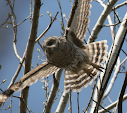
Here is one little bird that I had hoped to share, with its identity already confirmed; but once again I am stuck. If anyone has insights please let me know. The possibility is strong that I have missed something, but I will lay out my thoughts and pitfalls with the following pictures.
First off, this bird was seen foraging among wildflowers alongside one of the lakes on the Summit County side of Loveland Pass. I would put the elevation somewhere around 11,750 ft., but don't have that confirmed beyond association with the summit of the pass which is 11,990 ft.
The bird was just outside of some willow clumps, and was in close proximity to a handful of White-crowned Sparrows. It was quiet, or at least not vocalising loudly enough to overpower the wind and Pikas. Initially, I thought this was a White-crowned as well, just a young bird with a bunch of adults. As I began to double check though, some issues with that species began to arise.

First off, the bird is heavily streaked on the throat and underparts, which should be a solid light gray on a White-crowned; even a juvenile bird. Also, it seems that the dark crown-stripe drops down into the lores, (that area above and in front of the eye), too completely for an interior White-crowned. That pattern looks right for a Pacific, but again - the striping shouldn't be present.

To get myself a list for cross-checking I searched eBird records for some of the Tundra habitat Colorado Hotspots, and pulled a list of all the August results. The candidates I looked at more closely were; Chipping Sparrow, Song Sparrow, Lincoln's Sparrow, Brown-capped Rosy-Finch, Cassin's Finch, and Pine Siskin.
I believe I have eliminated each as a pure species for the following respective reasons. The Chipping Sparrow, coloring is wrong, and the presence of striping is not correct. For a young bird though, the head pattern was close. The Song Sparrow, didn't seem that likely, and on comparison this bird doesn't show the same pattern of breast streaking or a central breast spot. Its eye-line runs straight back, not curving down like that of a Song Sparrow. A Lincoln's Sparrow seems more likely for a hybridisation, with the buffy wash and more streaking, but this bird is lacking the neck pattern - specifically a strong malar stripe, central breast spot, and fine streak pattern for a pure Lincoln's. I looked closely at the Brown-capped Rosy-Finch mainly because I am still seeking one (unless one of my long range pictures from earlier in the trip turns up a hidden gem). Besides hope, there really wasn't much a Rosy could add to the process. The Cassin's Finch did have more concrete contributions, specifically the streaking on the neck and underparts, and a fairly plain face pattern below the eye. The strong eye-line and pattern on the back aren't right, however. Of course, when looking at streaky mountain birds the Pine Siskin has to come to mind. On this bird the bill shape, leg color, and lack of strong wing-bars make that species unlikely as well.

So, a 'pure' species of any kind still doesn't seem close, but again, I wouldn't be terribly shocked if I was missing something out there that fits. A hybrid of one or more of these species may be more likely, but I didn't find much documentation for some of the more likely pairs. Also, I had another bird that appeared to match this one, but at a greater distance, and with poorer light. It is possible that the same bird moved between two locations while I was shooting - or that the two birds were siblings, but that may make hybrid a less likely option.

I believe my best guess is some kind of Lincoln's Sparrow mix, but I haven't found clear indication about the malar stripe on a young bird of the species.
If anyone has an answer for me, please feel free to share. The tough birds are the ones where we learn the most, and I have been digging on this one quite a bit. Thanks for considering, and I will have more pictures from this spot shortly, it was a great stop.
Also, while searching online the past few evenings I have been unable to find a handy and reliable list of most species that can be found in the tundra area. The lists you find for Tundra habitat feature the handful of species that are common there, but unlikely in other habitats, such as White-tailed Ptarmagin, Brown-capped Rosy-Finches, and White-crowned Sparrow. Anyone know of a list where you could sanity check to confirm that the bird you thought was a Downy Woodpecker would be really unlikely up there. For instance I see Bluebirds with some regularity up at the Alpine Visitor Center in RMNP, but because they are much more common in lower parts of the list they show up in park lists, but are not associated with the Tundra habitat. If anyone has a list that they use, or just has built one up with more experience than I have and can point me to it I would appreciate it.


Hey Dave, I think you are looking at a really young juvenile White-crowned Sparrow. They usually are very streaky in their first plumage. You can see the brown crown color under the blackish that seems to be spattering everything on the bird. I believe the black on the head will wear off to the typical brown strips on a 1st winter whitey.
ReplyDeleteThanks Connie, I did some searches on "fledgling" and "nestling" W-c Sparrows and finally found a couple of pictures showing the streaking - which made sense all along for a young bird. I appreciate the clarification/confirmation.
ReplyDeleteIt looks a bit like a Song Sparrow - it could also be a female or juvenile sparrow. It looks young.
ReplyDelete